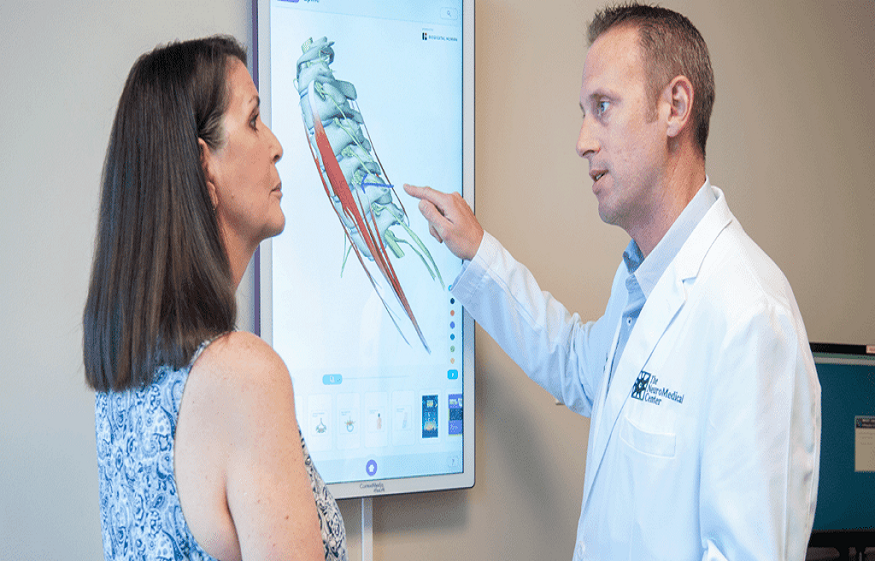Spinal care often requires a collaborative effort among surgeons, physical therapists, radiologists, neurologists and pain specialists. The best outcomes happen when these professionals work in sync, sharing their expertise and aligning on treatment goals. Dr. Larry Davidson, a leader in spinal surgery, recognizes that Artificial Intelligence (AI) is becoming a valuable tool in strengthening this coordination. It helps streamline communication and supports teams in delivering truly patient-centered care.
AI systems provide shared insights based on predictive analytics, imaging analysis, patient-specific modeling and recovery tracking. These tools help multidisciplinary teams align around a common understanding of each case. With access to the same real-time data, providers can make more consistent decisions and contribute effectively to the patient’s long-term progress.
Why Multidisciplinary Teams Are Essential in Spine Care
The complexity of spinal disorders demands more than one perspective. A patient recovering from disc replacement surgery, for instance, may need surgical follow-up, physical therapy, pain management and psychological support. Similarly, a patient with scoliosis or spinal instability may require input from neurologists, orthopedic specialists and rehabilitation providers.
This collaborative model is designed to provide holistic care, but without shared data and streamlined communication, these efforts can become fragmented. AI offers a solution by serving as a centralized source of information and actionable insights that every provider can access and contribute to.
How AI Enhances Communication and Coordination
AI platforms can integrate data from electronic health records, imaging systems, wearable devices and provider notes to build a comprehensive, up-to-date profile of each patient. These platforms can highlight risk factors, track recovery trends and alert providers to deviations from expected outcomes.
This shared visibility allows each team member to stay informed, without relying solely on traditional documentation or time-consuming meetings. A physical therapist, for example, can view AI-generated projections about post-operative mobility goals, while a pain specialist can review predicted pain responses based on pre-surgical assessments.
Supporting Personalized and Adaptive Care Plans
AI helps multidisciplinary teams tailor care strategies that reflect the patient’s full context, not just their imaging results or symptom descriptions. Based on dynamic inputs, algorithms can flag potential complications, recommend therapy modifications and prioritize areas of concern.
Strengthening Preoperative Assessments and Planning
AI also enhances team collaboration before surgery. Predictive modeling tools allow radiologists, surgeons and anesthesiologists to assess patient-specific risk profiles and simulate how different surgical techniques may affect alignment, function and long-term outcomes.
These insights help the team align on the safest and most effective approach, whether that’s selecting a specific implant, modifying anesthesia protocols or scheduling prehabilitation sessions with physical therapy before the procedure. The result is a more proactive, customized strategy that reflects every team member’s input.
Post-Operative Monitoring and Adjustment
After surgery, AI tools continue to support the team by tracking patient progress in real-time. From wound healing and pain levels to gait analysis and spinal loading, AI-driven systems can collect and synthesize a wide range of recovery metrics.
When a physical therapist notices a limitation in mobility or a nurse tracks changes in vitals, AI analyzes these data points and shares them with the broader team. If issues are detected, the platform can recommend follow-up steps, notify relevant specialists and even predict the likelihood of readmission.
This feedback loop ensures issues are addressed early before they evolve into setbacks.
Facilitating Consistent Education and Engagement
AI-driven platforms can also deliver patient education content that aligns with the care team’s goals. Whether it’s recovery exercises, medication schedules or guidance on lifestyle adjustments, these tools reinforce the team’s recommendations with consistent messaging.
Patients receive personalized updates, visual progress tracking and timely alerts when milestones are met or missed, encouraging active participation in their recovery. When the entire care team shares access to a unified communication system, patient education becomes more consistent and effective.
Training and Decision Support for All Team Members
Beyond direct patient care, AI systems provide decision-support tools that benefit every provider on the team. For example:
- Radiologists receive image enhancement tools that flag subtle abnormalities.
- Surgeons gain access to real-time surgical planning simulations.
- Therapists can explore recovery models based on similar patient profiles.
- Pain specialists can review predicted opioid needs or alternative protocols.
This access to AI-driven decision support empowers every discipline to work at its best, informed by collective insights.
Ensuring Accountability and Quality Assurance
AI tools help track performance and outcomes across the entire care team. Dashboards can highlight trends, success rates, patient feedback and efficiency metrics, enabling internal reviews, accountability and process improvement.
When outcomes diverge from expectations, the care team can work together to evaluate causes, refine treatment protocols or reallocate resources. This collaborative, data-driven approach drives continuous improvement and enhances long-term patient outcomes.
Ethical Considerations and Human Oversight
While AI facilitates communication and collaboration, it must always be implemented with transparency, data privacy protections and clear clinical oversight. Final decisions still rest with medical professionals who understand the nuances of patient care that AI cannot capture.
Teams should view AI as an enhancement to their workflow, not a replacement for critical thinking, experience or human empathy.
The Future of AI-Driven Team Collaboration
As healthcare becomes more connected and data-rich, AI’s role in multidisciplinary spine care will only grow. We can expect tighter integration between systems, expanded predictive modeling across specialties and more robust tools to support collaborative treatment strategies.
Dr. Larry Davidson shares, “If the progress we’ve seen in just the last decade is any indication, we can expect continued breakthroughs, not only in surgical techniques, but also in the technologies that support spine surgeons in achieving optimal outcomes. It’s hard not to feel excited about what lies ahead on this path of innovation.” His perspective highlights the broader transformation underway,where technology not only advances surgery but also strengthens the systems that support team-based care.
Virtual care rooms, AI-powered coordination platforms and voice-activated tools may become standard, helping teams stay aligned regardless of location or complexity. As this integration deepens, spinal care will become more efficient, adaptive and centered around the shared goal of improving patient outcomes.
Smarter Collaboration for Stronger Outcomes
Multidisciplinary care has long been essential to spinal treatment, but AI is now helping those efforts reach new levels of precision and coordination. By giving every team member access to real-time data and predictive tools, AI helps unify care around shared goals and personalized strategies.
With clearer communication, better planning and earlier interventions, care teams are better equipped to deliver consistent, high-quality outcomes. As these technologies become more advanced and accessible, they will support a more connected, efficient and responsive model of spinal care. The result is stronger collaboration, improved decision-making and care that truly reflects the needs of each individual patient.

